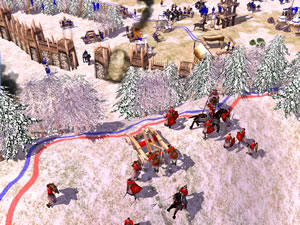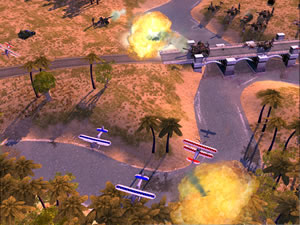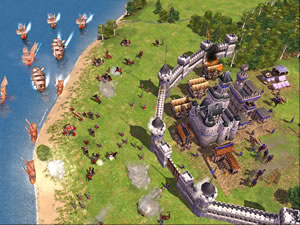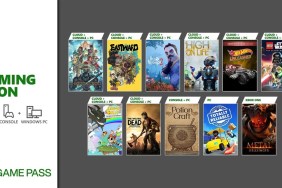Everybody wants to rule the world.
There’s just no easy way to mesh our pre-history with our present technology. Handing a Neanderthal a lighter might seem like fun, but would do little to help him take down an Abrams tank. Likewise, that tank doesn’t seem very tough when lined up across from a giant mech. Can a horse kick a jet’s ass? Not unless it has wings.
But Empire Earth II embraces such technological inconsistencies, allowing you to enjoy the breadth of our history’s war experience by letting you battle throughout the ages. At the same time, the game manages to retain its solid RTS foundation while making an evolutionary leap with loads of new features and functions. The result is a monstrously deep strategy game that will have fans of the genre happier than an ape with a bazooka.
To help you cope with this depth, the interface has been cleaned up, presenting data in a more logical manner. Still, the sheer amount of new options will intimidate casual strategy fans, at least through the initial tutorial run.
Much like the original, Empire Earth II is an epic game spanning fifteen epochs and civilizations, beginning with the early days of hunters and gatherers and winding up in the distant, sci-fi future. Each era comes packed with units (totaling a whopping three hundred), leading to a strategy game so large and complex it’s almost hard to wrap your head around.
One of the major new features in Empire Earth II is the ability to switch between field view and a full- screen, overhead map. The map displays visual data relating to resource mines, unit movement, and building positions and is great for quickly jumping to any point on the battlefield. And a sweet Citizen Manager tab allows you to keep tabs on the influx of resources as well as the idle pockets of workers, keeping your people right where they should be – under your thumb.
Another Overhead map feature called War Planner allows you to quickly draw arrows, targets, areas, and/or labels atop the Overhead map, send a copy of your coordination proposal to allies for approval, and launch well-orchestrated strikes between multiple fronts. In keeping with our species’ love of exploiting tools, you can also “accidentally” send “faulty” plans to enemy players as a bluff’and then send him the real ones next time, just to keep him guessing. As a nice design touch, your War Plans remain drawn over your mini-map.
 Whether you’re in field or Overhead map view, a Picture-in-Picture display lets you keep a close eye on a given area of interest. Every friendly object in the PiP is controllable, so you can follow your troops into battle with the main window, set your PiP on a barracks and quickly reinforce yourself without having to take take your eyes off the action. Alternatively, you can keep a scout in the PiP to scope out the enemy’s defensive holes or watch your flank for a counter-attack. The possibilities are as bad-ass as they are endless.
Whether you’re in field or Overhead map view, a Picture-in-Picture display lets you keep a close eye on a given area of interest. Every friendly object in the PiP is controllable, so you can follow your troops into battle with the main window, set your PiP on a barracks and quickly reinforce yourself without having to take take your eyes off the action. Alternatively, you can keep a scout in the PiP to scope out the enemy’s defensive holes or watch your flank for a counter-attack. The possibilities are as bad-ass as they are endless.
You also have a great degree of control over your units’ behavior. You can set offensve and defensive formations to suit the conditions of a battle, and units will break formation to attack, then fall back in line when the carnage is over. At times, however, when commanded to an area on the opposite side of the map, units will take the shortest path to the target and get stuck for a couple of seconds as they figure out another route. This pathfinding problem is a common annoyance, not a dealbreaker.
Three single-player campaigns follow the Koreans, Americans, or Germans from varying eras in their respective histories. As a bonus, you may also take on D-Day as either the Germans or Americans and control either Wu or Wei’s side of the Three Kingdoms power struggle in ancient China. The campaigns mostly serve as proving grounds for all of the skills you’ll want to master in multiplayer.
You can create battles for up to ten players, be they Human or Computer controlled. Nine victory conditions are also available, including King of the Hill and various Score measurement modes. The nerds will dig the fully functional map editor; go ahead and make a map huge enough to span all fifteen epochs’if you dare, dork.
 For the most part, the gameplay has remained fundamentally the same having you research, build and destroy. A new reward device, Crowns, helps bolster some of the team play dynamics by letting you buy upgrades. You may beef up your naval fleet or ground troops if you’re the team’s warlord, since you will be awarded for successes in the Military category. If you’re more of a defensive player, Crowns will be awarded to you in either the Imperial or Economic categories. In addition to trading resources and troops, you can also trade whole territories, opening up other strata of negotiation between players.
For the most part, the gameplay has remained fundamentally the same having you research, build and destroy. A new reward device, Crowns, helps bolster some of the team play dynamics by letting you buy upgrades. You may beef up your naval fleet or ground troops if you’re the team’s warlord, since you will be awarded for successes in the Military category. If you’re more of a defensive player, Crowns will be awarded to you in either the Imperial or Economic categories. In addition to trading resources and troops, you can also trade whole territories, opening up other strata of negotiation between players.
Considering its leap forward in terms of gameplay depth, Empire Earth II delivers a stagnant visual package. At a distance, the textures and polygon count seem acceptable, but the ability to zoom in reveals jagged lines and clunky animations. With so much going on, the lackluster visuals of Empire Earth II are partially forgivable, and at least the framerate stays high throughout. Still, we would have preferred a fancier new engine to go with the fancy complexity.
The minimalist music differs depending on the civilization you choose, subdued enough so as not to detract from the roar of thunder and the arrows whipping through the air. The sound effects are all entirely believable, though the unit dialog is very repetitive. You’d think somewhere in all that evolution, someone would have invented a thesaurus.
Still, Empire Earth II succeeds far, far more often than it fails. The ability to multitask is essential to the success of any RTS player, but few interfaces have so naturally supported this fact. The strategic possibilities are limited only by the skill of the player. It’s likely too complex for some and isn’t without a few hiccups, but those with patience to burn will find this a bright candle indeed.
-
Graphics are Stone Aged
-
Goony pathfinding
-
Some great interface innovations
-
Incredible depth
-
Supreme control











